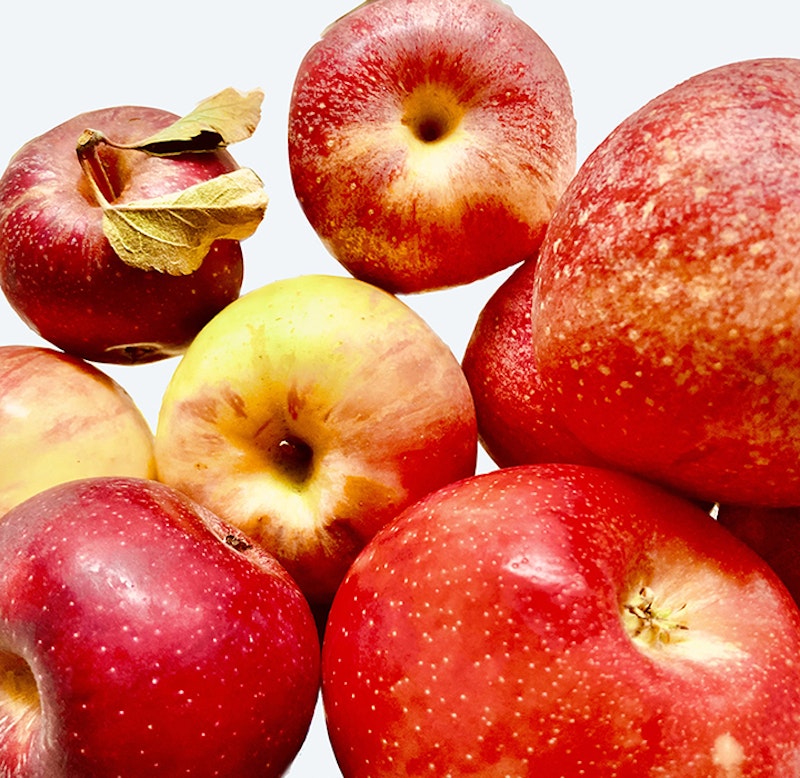An abundance of orchard fruit gleamed in the autumn light at the Union Square farmer’s market. Despite an elbow-to-elbow mass of shoppers, I wedged into Migliorelli Farm’s produce stand and grabbed a high-quality apple. Ready for my first bite of the season, the Northeast crop’s red skin snapped with a delicate crunch. The honey-like and tart flavor went all the way to the core. The seeds contain traces of cyanide; avoid eating them. Apple growers believe, in spite of unpredictable factors like drought, hailstorms, pests and diseases, it’s a plentiful year for apples.
In business, culture, and mythology, apples are important. When considering eras from a biblical standpoint, for instance, there are two parallels. Malus domestica, the “hermaphrodite” plant, is a member of the rose family. Malus is a Latin word that means both apple and evil. Bear in mind, with temptation comes responsibility.
In Eden’s Garden, Satan lived on the Tree of Knowledge disguised as a sly, talking snake. Speaking to Eve, the serpent persuaded her to taste some of the tree’s forbidden treats; defying God’s “Do Not Eat” order. Adam had a bite too. History may have unfolded differently had Eve taken a straight and narrow course. Naked and afraid, they clutched fig leaves. Adam and Eve were banished from the garden. Adam went off to work and Eve had labor pains delivering Cain, Abel and Seth. It’s thought that the fruit eaten was an apple.
The impact of written-word styles uses rhetorical devices like merism; words for words sake. Religious beliefs employ this for persuasion and alliteration; the symbols of good and evil as well as Heaven and Hell appear out of nowhere, which means everywhere.
For some odd reason to stress the point, the Los Angeles big hair band band Ratt’s 1984 song “Round and Round” springs to mind. It crosses generational divides and features a cameo by Milton Berle appearing in drag. Writers, poets, and musicians often use this technique along with cadence in their bag of tricks.
Another Milton, John Milton, expanded the Genesis chapter in his epic poem Paradise Lost to his satisfaction in 1667. His ideas, which frequently disagreed with the Catholic Church, were considered blasphemy. Apples are associated with Snow White, Steve Jobs, William Tell, and the “Apple Scruffs” as George Harrison called the diehard Beatles fans that hung around outside Apple Records London’s Abbey Road Studios in the 1960s.
The US Postal Service released a five-cent postage stamp in 1966 celebrating of a folktale hero known as Johnny Appleseed. In the 1800s, the nurseryman journeyed alone along waterways to gather seeds from Pennsylvania’s cider mills with the goal of reaching the Midwest’s frontiers. The real John Chaplin (1774–1845) wore torn trousers underneath an old coffee sack and went barefoot. Imagine how scared a hiker would be these days if they came across a filthy, destitute hippie in the woods. In The Botany of Desire author Michael Pollan profiles the eccentric along with apples. Walt Disney reimagined Johnny Appleseed in 1948 with a sanitized “Aw, shucks!” version for wider audience appeal.
Back to the 19th-century frontiers, one way for settlers to claim land was starting an orchard. Appleseed, the businessman, shared his Bible devotion to homesteaders while planting trees for pennies. After spreading seeds around during the day, he slept outside at night on the ground with his tough, naturalist feet facing the campfire. But really the kickback here was the alcohol. When the trees reached maturity, the apples produced hard cider, which was safer to consume than most water back then.
From my childhood recollections growing up in Baltimore, here’s a bye-bye apples memory. Our one-acre yard had cherry, mulberry and apple trees. A common fall activity was an onslaught of neighborhood kids ready for rotten apple battles using metal garbage cans on their side as cover. One of the yard’s decaying apple trees leaned at an angle presenting a hazardous situation. With a hatchet and some ropes, my father ascended the tree, and it gradually vanished. As a budding young arborist who was interested in learning more, breaking apart sections of the strewn branches and trunk was part of my job. I wore shorts that day; my legs were covered in wood chips and dust.
But there was unknown danger present. I’d no idea what was about to happen as I stepped on a live yellowjacket nest; angry black and yellow stripes appeared everywhere! Imagine my horrified expression swatting away, as I performed some terrible dance moves. Remember, these insects have yet to gain widespread mainstream popularity as names for TV series and sports teams.
The next school day, I treated my bites and stings with Calamine lotion, packed my brown A&P grocery-bag-covered textbooks and took a moment to fasten them with a pink rubber band book strap. Then it was off to school. I didn’t want to miss the chance to brag about the bee attack in the schoolyard. I also made sure to include an apple in my lunchbox.

